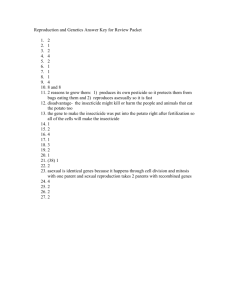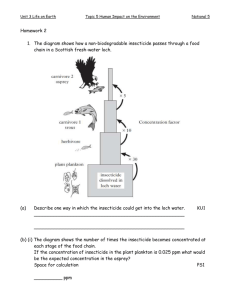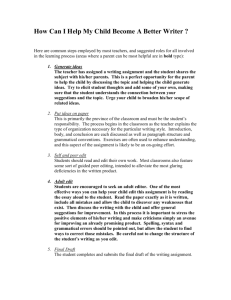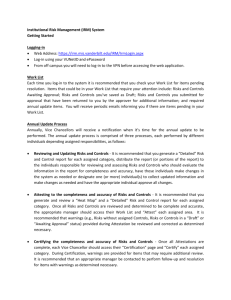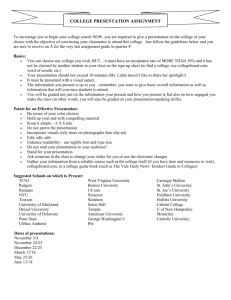Understanding Insecticide Mode of Action in Crop Protection
advertisement
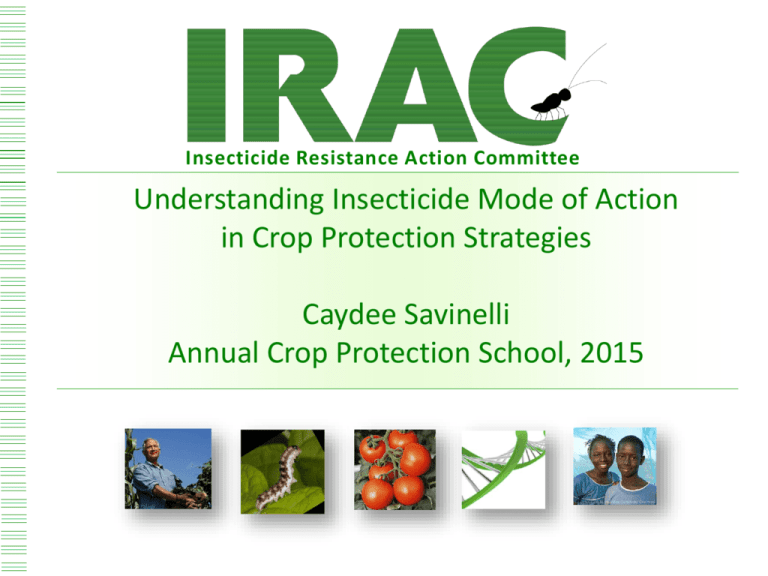
Insecticide Resistance Action Committee Understanding Insecticide Mode of Action in Crop Protection Strategies Caydee Savinelli Annual Crop Protection School, 2015 ClickInsect to edit Resistance Master title style • Experts estimate that there are over 500 species of insects and mites known to be resistant to at least one class of pesticide. • Every major agricultural crop and ornamental has one or more resistant pests. • In addition to synthetic chemicals, pests can develop resistance to insecticidal soaps, B.t. and even pheromone disruption. 2 ClickResistance to edit Master title style Insect Mechanisms • Target Site Resistance The target site is where the insecticide acts in the insect. May be genetically modified to prevent the insecticide binding or interacting at its site of action – reduces the effect of the insecticide. • Metabolic Resistance Metabolic resistance is the most common mechanism. Resistant insects may detoxify or destroy the toxin faster than susceptible insects, or quickly rid their bodies of the toxic molecules. Insects use their internal enzyme systems to break down insecticides. Resistant strains may possess higher levels or more efficient forms of these enzymes. 3 ClickResistance to edit Master title style Insect Mechanisms • Penetration Resistance Outer cuticle of the insect slows the absorption of a broad range of chemicals. Penetration resistance is often present along with other forms of resistance. • Behavioral Resistance Resistant insects may detect or recognize a danger and avoid the toxin. This mechanism of resistance has been reported for several classes of insecticides, including organochlorines, organophosphates, carbamates and pyrethroids. 4 to editofMaster title style What isClick the level arthropod resistance? • Over 550 species of arthropods are resistant to pesticides 88% insects, 12% mites • Most of those insects come from 4 groups: Coleoptera (Beetles) Diptera (Flies) Hemiptera (Sucking Bugs) Lepidoptera (Moths & Butterflies) • 60%+ of all resistant arthropods are agricultural pests • Rest are: animal health (ticks and lice) public health (flies, mosquitoes, cockroaches) stored product pests (grain beetles) non-target organisms (predatory mites) Source: Arthropod Pesticide Resistance Database – Michigan State University Click to edit Master title style Leading Global Resistant Agricultural Arthropods Common Name Species Order No. active ingredients Two Spotted Spider Mite Tetranychus urticae Acari 79 Diamondback Moth Plutella xylostella Lepidoptera 76 Green Peach Aphid Myzus persicae Hemiptera 68 Colorado Potato Beetle Leptinotarsa decemlineata Coleoptera 48 Silverleaf Whitefly Bemisia tabaci Hemiptera 39 European Red Mite Panonychus ulmi Acari 38 Cotton Aphid Aphis gossypii Hemiptera 37 Cotton Bollworm Helicoverpa armigera Lepidoptera 33 Tobacco Budworm Heliothis virescens Lepidoptera 33 Egyptian Cotton Leafworm Spodoptera littoralis Lepidoptera 30 Source: Arthropod Pesticide Resistance Database – Michigan State University Does insecticide resistance mean the total Click to edit Master title style loss of insecticides? • With current agricultural practices, the development of insecticide resistance is inevitable. • However, even though there is resistance, this does not mean the insecticide is no longer effective. • With crop protection insecticides, it is possible to manage resistance and maintain susceptibility. Organophosphates Introduced Pyrethroids Introduced Neonicotinoids Introduced 7 to edit Master title Are someClick insects more prone tostyle resistance ? • Common claim that some insects are more prone to resistance development than others. • Exposure to insecticide is key factor. • Some insects, do appear to develop resistance faster than other species, even if insecticide exposure is the same. 8 Click at to edit titleresistance? style Are mites highMaster risk for • 20 acaricide modes of action (MoAs) • Two spotted spider mite (Tetranychus urticae) has developed resistance mechanisms against 17 MoAs • Many populations have resistance to multiple MoAs • Resistance develops rapidly in green houses Closed environment (limited gene flow) All year production High value crops – low tolerance of pest Mites - High fecundity, Short generation time • Resistance in field crops generally slower 9 IRM Implementation Click to edit Master title style Key Groups IRAC Industry Insecticides or Traits University EPA 10 Insecticide Click to Resistance edit Master Management title style IRAC’s Role • IRAC-US is a task force affiliated to CropLife America. IRAC is comprised of scientists representing many companies which develop and market agricultural chemicals Allows companies to effectively pool resources on IRM-related issues; especially, with related chemistries or traits. Individual companies do not have the resources to carry out all aspects of IRM - Collecting & Monitoring • Gains alignment on IRM recommendations and educational messages • Serves as a coordinating group for outlining methodologies for resistance surveys • Provides funding to address emerging resistance issues i.e. – Soybean looper Click to edit Master title style IRAC Website - www.irac-online.org Insecticide Click to Resistance edit Master Management title style Industry View • Resistance, real or perceived, can greatly diminish the value of products in the marketplace Increase in number & frequency of applications Product non-performance complaints go up and farmer confidence goes down • Resistance reduces the effective life of a product Shorter product life will lower the return on investment With discovery and registration costs of $200-350 million and development timelines of 8-15 years, it is important to maintain the current products in the market. • Resistance management is an important component of product stewardship 13 Insecticide Click to Resistance edit Master Management title style Industry’s Role • Expertise Research & Development, Registration, Product Stewardship • Interactions RACS, Universities, Consultants, IPM Centers, Customers • Labels Mode of Action Labeling Effective rates and use patterns to minimize selection pressure Resistance Management Guidance Clickof to Action edit Master title style Mode Classification • All products have been assigned to groups based on their mode of action: i.e. pyrethroids are Group 3; Neonicotinoids are Group 4A, Spinosad is Group 5, Diamides are Group 28 • Product labels include the number corresponding to the mode of action group. • The aim is to help product users make better decisions such as product rotations or tank mixing. IRAC - Insecticide Mode of Action Classification Insecticide Resistance ActionMaster Committee Click to edit title style www.irac-online.org Growth & Development Targets Group 7 - Juvenile hormone mimics Group 10 - Mite growth inhibitors Group 15 - Inhibitors of chitin biosynthesis Group 16 - Inhibitors of chitin biosynthesis Group 17 - Molting disruptor Group 18 - Ecdysone agonists / molting disruptors Nerve & Muscle Targets Group 1 - Acetylcholinesterase (AChE) inhibitors 1A Carbamates, 1B Organophosphates Respiration Targets Group 12 - Inhibitors of mitochondrial ATP synthesis Group 13 - Uncouplers of oxidative phosphorylation Group 20 - Mitochondrial complex III electron transport inhibitors Group 21 - Mitochondrial complex I electron transport inhibitors Group 23 - Inhibitors of acetyl CoA carboxylase Group 25 - Mitochondrial complex II electron transport inhibitors Group 2 - GABA-gated chloride channel antagonists 2A Cyclodiene Organochlorines, 2B Phenylpyrazoles Group 3 - Sodium channel modulators 3A Pyrethrins, Pyrethroids Group 4 - Acetylcholine receptor (nAChR) agonists 4A Neonicotinoids, 4C Sulfoxaflor, 4D Flupyradifurone Group 5 - Nicotinic acetylcholine receptor channel agonists Spinosyns Group 6 - Chloride channel activators - Avermectins Group 9 - Modulators of Chordotonal Organs Group 14 - Nicotinic acetylcholine receptor channel blockers Group 19 - Octopamine receptor agonists Group 22 - Voltage dependent sodium channel blockers Group 28 - Ryanodine receptor modulators - Diamides Midgut Targets Group 11 Microbial disruptors of insect midgut membranes 11A Bacillus thuringiensis, 11B Bacillus sphaericus IRAC-US IRM Plan Click to edit Master title style Plant Protection Insecticides • Determine insecticide mode of action. • Establish the baseline susceptibility of key high-resistance-risk pests prior to and/or in the early years of commercialization. • Include mode of action group on product labels. • Provide resistance management recommendations on product labels. • Encourage use of Integrated Pest Management (IPM) practices by growers. • Develop educational literature for growers, researchers and extension agents to increase resistance management awareness, particularly at the grower level. • Monitor product performance over a wide range of geographies and observe or track changes in the susceptibility of pest populations over time. 17 Click to edit Master title style Insecticide Mixture Statement Click to edit Master title style Insecticide Mixture Statement • Insecticide Mixtures Mainly used for pest management • Insecticide mixture considerations Active ingredients, use patterns, targeted pest complex. • Mixtures of insecticides provide technical advantages for controlling pests Increases level of target pest control Increases the spectrum 19 Click to edit Master title style Insecticide Mixture Statement • All of the following should be considered when using mixtures for IRM: Individual insecticides in mixtures should be highly effective & applied at effective rates. Mixtures with components having the same IRAC mode of action classification are not recommended for IRM. When using mixtures, consider cross-resistance issues between the individual components for the targeted pest/s. 20 Insecticide Click to Resistance edit Master Management title style EPA’s Role • For conventional pesticides, EPA has historically relied on voluntary measures to encourage proactive resistance management by pesticide users. • Agency-approved labels are an important tool, but resistance management labeling is voluntary (not mandatory for registrants). • Bt Plant-Incorporated Protectants (PIPs) – a special case: EPA places a high value on preserving the significant agricultural and environmental benefits of Bt PIPs EPA requires an Insect Resistance Management (IRM) plan for each registered Bt crop. • IRAC-US has provided a list of key pests with high potential for resistance and an insecticide resistance management plan to EPA 21 Insecticide Click to Resistance edit Master Management title style University’s Role • Lead or participate in the development of IRM plans • Provide education and lead implementation of IRM plans in respective geographies for the growers and crop consultants. • Monitor susceptibility of insects of concern. • Provide feedback to companies on successes and challenges with IRM plans. 22 Neonicotinoid & Implementation Click to IRM editPlan Master title style Bemisia tabaci – Arizona/California vs. Florida Florida • Single Host Crop Arizona / California • Multiple Host Crops Tomato Vegetables, Melons, Cotton • Tomato Season - August through May • Crops grown throughout the year. 23 Neonicotinoid & Implementation Click to IRM editPlan Master title style Bemisia tabaci – Arizona/California vs. Florida • IRM Plan Development Led by university extension entomologists Team – Chemical Companies, Crop Consultants, Grower Groups, Commodity Groups • IRM Plan Implementation Newsletters Meetings • Success Measurements Susceptibility monitoring Grower adoption surveys 24 Neonicotinoid & Implementation Click to IRM editPlan Master title style Bemisia tabaci – Arizona/California vs. Florida AZ / CA Recommendations FL Recommendations • Guidelines based on the cropping system • Cultural Controls Crop Hygiene Tomato free period • Neonicotinoids Application Method & Timing • Neonicotinoid Uses 25 IRM Plan & Implementation Click to edit Master title style Diamide Insecticides • IRAC Diamide Working Groups Formed before registration of MOA Group 28 products Global Alignment on IRM for Diamides • Identified key insects of concern – U.S. Insect Scientific Name Crop Diamondback Moth Plutella xylostella Brassicas Beet Armyworm Spodoptera exigua Vegetables Codling Moth Cydia pomonella Pome Fruit Colorado Potato Beetle Leptinotarsa decemlineata Potato 26 IRM Plan & Implementation Click to edit Master title style Diamide Insecticides – IRAC-US Diamide WG • Labels - MoA Symbol, Resistance Management Language • Collaborate with University Research & Extension Develop best management guidelines for IRM Literature pieces Address emerging issues 27 Click to edit Master title style Summary • Industry is motivated to have insect resistance management as part of our product stewardship efforts in order to protect the life of our products. • IRAC is the industry task force used to create IRM guidelines, educate and promote the value of insect resistance management in crop production, ornamentals and public health. • In order for insect resistance management to be successful, we need cooperation from all stakeholders!
